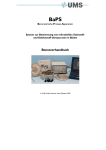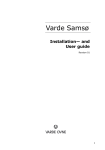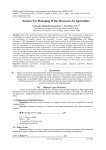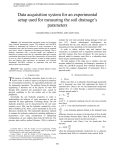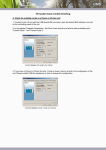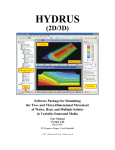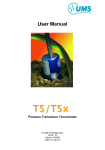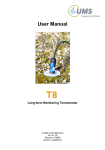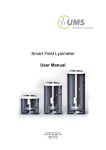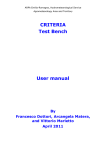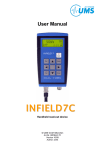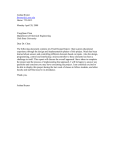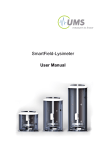Download HYPROP-FIT Manual
Transcript
1 HYPROP-FIT Software HYPROP-FIT User’s Manual Version 3.0, June 2015 1 2 HYPROP-FIT Software DISCLAIMER This manual documents the use of the HYPROP-FIT Software, a computer program for analyzing data from evaporation experiments and fitting the unsaturated soil hydraulic properties. HYPROP-FIT Software is a public domain product and may be used and copied freely. The code has been tested against a large number of soil hydraulic data sets, and was found to work correctly. However, no warranty is given that the program is completely error-free. If you do encounter problems with the code, find errors, or have suggestions for improvement, please contact Wolfgang Durner Soil Physics TU Braunschweig 38106 Braunschweig [email protected] Tel. +49 (0) 531 391 5605 or Thomas Pertassek UMS GmbH Gmunder Str. 37 D-81379 München [email protected] Tel. +49 (0) 89 12 66 52 CITE AS Pertassek, T., A. Peters and W. Durner (2015). HYPROP-FIT Software User’s Manual, V.3.0, UMS GmbH, Gmunder Str. 37, 81379 München, Germany, 66 pp. THIS MANUAL INCLUDES THE SHYPFIT 2.0 USER MANUAL AS APPENDIX 3, TO BE CITED AS Peters, A. and Durner, W. (2015). SHYPFIT 2.0 User’s Manual. Research Report. Institut für Ökologie, Technische Universität Berlin, Germany. 2 3 HYPROP-FIT Software Content 1. Overview and Scientific Background ............................................................................................... 6 2. Installation of the Software ............................................................................................................. 8 2.1 Installation using the Microsoft Installer ...................................................................................... 8 2.2 Access rights: Public User and Power User ................................................................................... 8 3. Starting the Software and Loading a Project................................................................................... 9 3.1 Starting the program ..................................................................................................................... 9 3.2 Opening, processing and storing projects - the commands File, Extras, Help ............................ 10 3.2.1 Reading HYPROP-VIEW project data from old HYPROP measurement campaigns ............. 11 3.2.2 Menu “File” - Opening, modifying, and storing HYPROP projects ....................................... 11 3.2.3 Menu “Extras” – Converting and joining files ...................................................................... 13 3.2.4 Menu “Help” – HYPROP-FIT version information................................................................. 14 4. Processing Data ............................................................................................................................. 15 4.1 Register »Information« – Specifying the required parameters for the measurement ............... 16 4.2 Register »Measurements« - Visualization and editing of measured data .................................. 23 4.2.1 Interpretation of the tensiometric data ............................................................................... 23 4.2.2 Data Visualization Options ................................................................................................... 24 4.2.3 The tension graph ................................................................................................................. 25 4.2.4 Using the air-entry point of the tensiometer cup as additional tension measurement (Power User only) .......................................................................................................................... 26 4.2.5 The weight graph .................................................................................................................. 27 4.2.6 The tension data window ..................................................................................................... 28 4.2.7 The weight data window ...................................................................................................... 28 4.3 Register “Evaluation” - Calculating retention and conductivity data.......................................... 29 4.3.1 Calculation of retention and conductivity data .................................................................... 29 4.3.2 Calculation of absolute water contents ............................................................................... 29 4.3.3 Adding independent retention and conductivity data ......................................................... 31 4.3.4 Modifying evaluation parameters (Power User only) .......................................................... 32 4.4 Register »Fitting« - Fitting hydraulic functions to the data......................................................... 33 4.4.1 Fitting functions.................................................................................................................... 33 4.4.2 Selecting a model and specifying parameter bounds .......................................................... 34 4.4.3 Results of the parameter estimation and uncertainty measures ........................................ 35 4.4.4 The function graphs.............................................................................................................. 36 3 4 HYPROP-FIT Software 4.4.5 Field capacity and plant available water .............................................................................. 37 4.4.6 Modifying optimization parameters (Power User only)....................................................... 37 4.5 Register “Export” - Exporting data, graphs, functions, and parameters ..................................... 39 5. Processing multiple data sets ........................................................................................................ 42 6. References ..................................................................................................................................... 43 APPENDIX 1: Theoretical basics of the Simplified Evaporation Method ............................................... 44 APPENDIX 2: Automatic estimation of the initial water content .......................................................... 48 APPENDIX 3: SHYPFIT2.0 User‘s Manual ............................................................................................... 49 1. PDI model combinations ................................................................................................................... 50 1.1 Retention functions ..................................................................................................................... 50 1.1.1 General ................................................................................................................................. 50 1.1.1.Adsorptive saturation function ............................................................................................ 50 1.1.2 Capillary saturation function ................................................................................................ 51 1.2 Conductivity functions................................................................................................................. 53 1.2.1 General ................................................................................................................................. 53 1.2.2 Capillary conductivity ........................................................................................................... 53 1.2.3 Film conductivity ................................................................................................................. 55 1.2.4 Prediction of isothermal vapor conductivity ........................................................................ 56 1.3 Capacity functions ....................................................................................................................... 57 2 Other soil hydraulic functions ............................................................................................................ 59 2.1 Brooks and Corey function .......................................................................................................... 59 2.2 Fredlund and Xing model ............................................................................................................ 59 3. Parameter estimation........................................................................................................................ 62 3.1 Definition of objective function................................................................................................... 62 3.2 Integral versus classic fit.............................................................................................................. 62 3.3 Weighing schemes ....................................................................................................................... 63 4. Post processing .................................................................................................................................. 65 4.1 Diagnostic variables ..................................................................................................................... 65 4.2 Uncertainty analysis .................................................................................................................... 66 4.2.1 Parameter uncertainties....................................................................................................... 66 4.2.2 Function uncertainties.......................................................................................................... 66 5. References ......................................................................................................................................... 67 4 5 HYPROP-FIT Software 5 6 HYPROP-FIT Software 1. Overview and Scientific Background HYPROP-FIT is a software tool for Windows™ environment. The software reads data that are recorded in projects by the data acquisition software “HYPROP-View”™ and stored in <.tvp> files. The files are converted to HYPROP-FIT files with the extension <.bhdx> (single measurement campaigns) or <.bhdix> (multiple measurement campaigns). Furthermore, separate data sets consisting of measured retention data and conductivity data can be imported and fitted, creating project files with the extension <.fitx>. HYPROP-FIT performs the following operations: (i) (ii) (iii) (iv) (v) (vi) Specification of all required parameters for the evaluation of the recorded experimental data with the simplified evaporation method (SEM), such as column length, positions of tensiometers, tare weights of the measurement device components, and so on. Visualization of the measured raw data, i.e., tensions and weight changes, dand specification of starting and stop points for the data evaluation. Re-calculation of tensions and net weight data as base for the calculation of retention and conductivity data. This includes the temporal interpolation for data in low temporal resolution, and the aggregation of data in very high temporal resolution. Calculation and visualization of the data for the retention characteristic and the conductivity characteristic. Fitting of state-of-the-art hydraulic functions to the data, visualization of the functions, and listing of the values and confidence limits of the hydraulic parameters. Export of graphs, raw data, calculated data, fitted functions, and other parameters of interest. The evaluation of HYPROP measurement campaigns follows the simplified evaporation method. This method uses weight changes of samples and the matric potential measurements in the samples during a drying process caused by evaporation to derive soil hydraulic functions. The principles of the method were first formulated by Wind (1968). A simplification of the Wind method, which is implemented in the HYPROP measurements, was proposed by Schindler (1980). Further advancements of the method are included in HYPROP-FIT, such as the extension of the measurement range towards higher suctions by using tensiometers with boiling retardation (Schindler et al., 2010a), and a further extension of the measurement range by considering the air-entry value of the porous cups of the tensiometers (Schindler et al., 2010b). The validity of the simplified evaporation method has been investigated by Peters and Durner (2008) and Peters et al. (2015). The detailed implementation of the method in the HYPROP-FIT software follows the description given in these papers. It includes features that lead to an optimization of the method, such as a corrected fit of the hydraulic functions by the “integral method” to avoid bias in hydraulic properties near saturation (Peters and Durner, 2006), an Hermitian spline interpolation to the raw measured data to obtain smooth and continuous time courses of measured data, and an automatic detection the validity range of conductivity data in the range near saturation, where the hydraulic gradient becomes too small to yield reliable data. The simplified evaporation method yields correct results for soils where the water flow is validly described by the Richards equation with time-invariant hydraulic properties, and where hydraulic properties that can be described with parametric expressions for hydraulic properties, including isothermal vapour diffusion (Peters et al., 2015). For further information about 6 7 HYPROP-FIT Software the scientific background of the method, the reader is referred to the scientific publications listed in the references section. HYPROP-FIT is freely available through the UMS website. 7 8 HYPROP-FIT Software 2. Installation of the Software 2.1 Installation using the Microsoft Installer The easiest way to install the software would be to call up the file "setup.exe" directly with the Explorer. Double-click on "HYPROP.msi". Then, follow the instructions on the screen of the installation assistance. If you cannot execute the file " setup.exe " you might need a current version of the Windows Installer® or/and .NET Framework 4.0 by Microsoft. 2.2 Access rights: Public User and Power User HYPROP-FIT is run in two user modes, which differ in the right to write or change parameters. “Public Users” run the software in a standard manner and apply default values for most specifications. “Power Users” are experienced and skilled users, trained in soil physics, and familiar with the scientific background of the data processing. A change of the user mode is done by selecting the appropriate mode at the lower right corner of the screen in a drop-down menu. A change of the user’s status can be done at any time and from any register. It will immediately be active. “Power Users” are allowed to alter many of the default values, or to manipulate measurement data. As an example, power users can edit or delete measured data records that are obvious outliers, or delete undesired records at the beginning or end of a measurement campaign. Furthermore, power users can process data that are measured on different devices, e.g. for evaporation experiments with different soil column heights. Changed parameters will affect the results of the data processing, and the implications on the calculations must be known by the users. In other words: if a Power User decides to alter parameters, he or she should really know what they are doing! 8 9 HYPROP-FIT Software 3. Starting the Software and Loading a Project 3.1 Starting the program To start the software, double-click the respective icon, or launch the software from the menu of installed programs. Upon the first start, an empty welcome screen will appear. If previous data sets have been loaded, HYPROP-FIT will automatically load the last-used data set. If the last exit of the program was not regular (e.g., a crash caused by a corrupted data file), the program will again appear with an empty screen. The welcome screen shows three header lines: (1) A top header line embedded in the blue window frame, which indicates the program name, with the project name in brackets (left), and the maximize, minimize and exit button (flushed right). (2) A command line which contains three commands “File”, “Extras”, “Help” (left) and a link to the UMS website (right). (3) An icon line with icons to open the “File explorer”, and a “Open file” and “Save file” button. Additionally the User level is depicted to the right of the bottom line. The settings can be altered by selecting the respective option in the draw-down menu that opens when clicking on the vertical triangle. 9 10 HYPROP-FIT Software 3.2 Opening, processing and storing projects - the commands File, Extras, Help All command uses follow the standard Windows System conventions, as known from typical Windows GUIs. To perform the actions, position the cursor on a command or entry. The selected entry will be highlighted. It is launched by a single click with the left mouse key. Some commands are on-off buttons. An example is the “File explorer” button in the third header line. Clicking on it will lead to the pop-up of a file explorer window on the left of the main window, clicking on it again will lead to its disappearance. Other commands open submenus, where further commands or options can be selected. Commands that cannot be actively selected in a certain situation are shown in grey and cannot be used. As an example, the “Save” button can only be used if a project has been opened and modified. Draw-down menus for selecting pre-defined options are indicated by vertical triangles on the right side of the respective button. Entries can sometimes be selected by key-combinations. If so, the combinations are indicated to the right of the respective entry. Menus can be left without any action by pressing the Escape button. Three types of data can be processed: Raw data from TensioView measurement campaigns (.tvp) performed with the HYPROP experimental setup Existing projects of type HYPROP binary project (*.bhd, or *.bhdx), HYPROP binary iteration project (*.bhdi, or .bhdix), or ASCII files (*_config.csv) with a predefined data structure. Separately measured retention and conductivity data in ASCII files (_RETC.csv and _COND.csv), or in a project file format (.fit or .fitx) The “x” extension indicates files that are processed with HYPROP-FIT 3.0 and higher. This new software version uses a slightly extended file format as compared to the previous HYPROP-Fit 2.0 versions. There is upward compatibility. This means that old projects (e.g., *.bhd) can be opened with HYPROP 3.0, but are then stored in the new .bhdx format. It is not possible to open the .bhdx files with the previous versions of the HYPROP-FIT software. The same applies to the .bhdi and .fit files. 10 11 HYPROP-FIT Software 3.2.1 Reading HYPROP-VIEW project data from old HYPROP measurement campaigns To import raw data from measurement campaigns that were performed with older versions of HYPROP-VIEW (at that time called tensioVIEW), open the submenu “Extras” and select the option “Convert tensioVIEW Project (tvp) files…”. The imported raw data will be automatically converted to HYPROP binary projects of type *.bhdx. After the successful import, immediately the selection of a target directory for the storage of the *.bhdx projects will be asked for. A new directory can be created and specified by pressing the respective button. Depending on the measurement mode (Single balance mode (=one balance for more sensor units) or Multi balance mode (= one balance per sensor unit), one or more *.bhdx files with the names of the measurement campaigns will be created in the target directory. 3.2.2 Menu “File” - Opening, modifying, and storing HYPROP projects The menu “File” is used to open and save project files, and to import measurement of retention and conductivity data. An existing data file is loaded by selecting the respective file name in the open window, as described below. After opening a file, five registers will appear. The registers are entitled »Information«, »Measurements«, »Evaluation«, »Fitting«, and »Export«. “Open” is the uppermost entry in the menu “File”. Four basic types of data files can be opened: .bhd HYPROP-FIT binary project file, containing information, .bhdx measurement data, calculated conductivity and retention data, and fitted functions for a single measurement campaign (DEFAULT) .bhdi A HYPROP-FIT iteration project file, including data and .bhdix fitted functions for multiple measurement campaigns. .csv csv files that contain HYPROP-FIT data in a structured manner. These files can be created in the “Export” register of the software (see section 5), externally modified, and re-imported. .bhdi A HYPROP-FIT iteration project file, including data and .bhdix fitted functions for multiple measurement campaigns. 11 12 HYPROP-FIT Software All files (*.*) Shows files with any extension. Only files with the selected extension will be shown in a browser window and can be opened by double-clicking on the name. “Save” is used to save a file which has been imported or processed. All changes will be saved. If no changes to an existing project have been made, the save button is inactive (grey shaded). “Save as” is used to save a file with a different name. Please note that you can open and process a file already during the stage of data acquisition with HYPROP-VIEW. However, this original file is write-protected as long as the measurement campaign continues. If desired, you can save it with a different name. “Import” is used to import data from csv files of type *_config.csv, which have been previously extracted and edited outside the HYPROP software, and are now re-imported. The subsequent group of entries in the File menu shows recently opened projects, allowing a direct and quick access to the projects by double clicking on the project name. “Close” closes the data file. If changes have been made, a confirmation to save changes is asked for. 12 13 HYPROP-FIT Software 3.2.3 Menu “Extras” – Converting and joining files This menu is used to open tensioVIEW projects from HYPROP measurement campaigns, and to combine individual measurements to combined projects. “Convert tensioView Project (tvp) files…” is used to read existing tensioView data files that have been produced by a HYPROP measuring campaign and stored by the data acquisition system in a tensioView project file. It opens a browser window, from where the files that are to be imported can be selected. The imported file will be immediately converted to one or more HYPROP binary data (.bhdx) files and can be stored and further processed. “Join files to an iteration file” is used to combine measuring campaigns that are stored as *.bhd or .bhdx files to one combined project file of type ‘.bhdix. It opens a browser window, from where the files that are to be combined can be selected. This is useful to compare different measurements and to fit retention and conductivity functions to multiple sets of data. Individual data sets will be shown in different colors, and can be switched on and off. 13 14 HYPROP-FIT Software 3.2.4 Menu “Help” – HYPROP-FIT version information The Help Menue consist of three entries. User’s Manual”. This entry gives direct access to the pdf version of this manual. This entry checks for updates of the HYPROP-FIT software. It requires Internet access. If an updated version is available, it opens a download wizard that helps to get an installation version of the updated software. The “Info” lists the HYPROP development team, and shows the disclaimer. 14 15 HYPROP-FIT Software 4. Processing Data The HYPROP-FIT software groups the data processing in up to five registers that encompass all steps of the data evaluation in a logical sequence of consecutive operations. Normally, the registers are followed consecutively from left to right. In all registers, data processing options can be specified, and data can be edited or manipulated. Common to all registers are the following points: - - - Editable values are shown in a edit field, i.e., surrounded by a frame with a slightly brighter background Values that cannot be modified are shown without the edit field. Whether or not a variable can be edited depends on the user mode: power users can edit more fields than public users. All variables that are expressed by numerical values are given with units. If a value is edited by the user, the inserted numerical value must be in the given unit. When inserting a numerical value, the proper decimal separator sign depends on the region settings of the computer. Default for the German Operating System is the comma, whereas default for the English one is a dot. Fields for numerical values do not accept input of alphabetical letters or special signs; if a user attempts to insert a non-permitted character, the field does not show the typed character. To be sure that an input operation is finished, the cursor must have left the input field. This is achieved either by pressing the Tab Key, or the Return key, or by moving the curser to another position in the window and clicking the left mouse button. In some menus explicit pressing of an “Accept” button is required. When placing the cursor on a button, a specific text information (Quickinfo) about the button’s function pops up for a period of some seconds. Some of the graphs and other contents have context-sensitive menus that are activated by placing the cursor on them and a right-click of the mouse. 15 16 HYPROP-FIT Software 4.1 Register »Information« – Specifying the required parameters for the measurement The »Information« Window contains nine groups of information blocks about the project. Some of the data are editable by the “Public User”, some more are editable by the “Power User”, and others that cannot be altered by the user and are listed as information that is specified by the TensioView or HYPROP-VIEW data acquisition program and the respective firmware. In a typical measurement evaluation, there is one single input value that must be specified by the user in this window: This is in group five “HYPROP Parameters” the “Empty soil sampling ring weight” [g]. Since the sampling ring weight differs from sample to sample, the weight of the ring must be specified for each individual measurement. In the following, the data groups will be listed and the inputs will be explained. Evaluation Method Currently, the Simplified Evaporation Method is implemented (Schindler, 1980; Peters et al., 2015). 16 17 HYPROP-FIT Software General Information Variable Explanation default value Sample Name Denomination of a sample. The name can be chosen freely by the user. It should be noted, that the sample name is used for the creation of the filename during export by default. The filename rules have to be considered. If data stem from a HYPROP measurement campaign, the sample name specified in HYPROP-VIEW is listed here. Date and time from the start of the recorded data. These data are given by the .tvp file. From HYPROP campaig n Date and time from the end of the recorded data. These data are given by the .tvp file. Start of measurement Stop of measurement Duration of measurements Ed.by public user Yes Ed.by power user Yes - No No - No No No No Difference between end and start date of the recorded data, calculated from the two fields above and rounded to full days Weight and Volume Correction Volume Correction Weight correction Correction of the sample volume. This can be necessary e.g., if the prepared sample surface is not perfectly prepared and shows deficits (negative correction). Volume correction will affect the calculation of the water contents, since the weight changes will be related to the value “Volume”+”Volume correction”. Addition (positive) or subtraction (negative) of a constant weight to the Tare weights, which are subtracted from the total weight to obtain the net sample weight. This could be the constant weight of, e.g., a lid, a cable, or another sensor that might be added in a measurement campaign. 17 0 cm³ No Yes 0g Yes Yes 18 HYPROP-FIT Software Geometric Parameters Variable default value Explanation Type of sample ring There are two standard types of sample ring: 250 cm² and 100 cm². The selectin of this entry will affect the subsequent default entries for surface area and height. Soil surface Surface are soil sample. Default value depends on area selection of cylinder type. Soil column Height of soil sample. Default value depends on height selection of cylinder type. Underfilling of cylinders or swelling of samples can require a modification of this entry. Position Height level of the measuring tip of the tensiometer lower with the short shaft, measured from the base of the tensiometer soil sample. Default value is valid for the UMS HYPROP device, where the lower tensiometer is located at ¼ of the total height. Position Position of the upper tensiometer in the sample, lower measured from the base of the soil sample. Default tensiometer value for the UMS HYPROP device is ¾ of the sample height Soil volume Volume of soil sample. It is calculated from the entries of area and height, and corrected for the volume of the two tensiometer candles (1 cm³). 18 250 cm³ ed. by public user Yes ed.by power user Yes 50 cm² No Yes 5.0 cm No Yes 1.25 cm No Yes 3.75 cm No Yes 249 cm³ No No 19 HYPROP-FIT Software HYPROP Parameters Empty soil sampling ring weight Exact mass of the soil sampling ring (dry and clean). IMPORTANT: THIS VALUE MUST BE SPECIFIED INDIVIDUALLY FOR EACH MEASUREMENT! The mass can be determined before or after the HYPROP measurement campaign. The default value is the mean value of the first series of sample rings provided by UMS. Wrong values transfer linearly to wrong calculated total water contents. An error of 2.5 g leads to a shift of calculated water contents of 1%. Measurement Mass of the dry, clean measurement base. The mass head net includes the two filled tensiometers and the silicon weight sheet that is used to separate the head from the measurement base, but with no water below the sheet. Normally, the weight is accurately derived from the default that is dependent on the serial number of the head. If uncertain, then perform a control measurement. For HYPROP devices that are long in use, it is advised to weigh them separately. Wrong values transfer linearly to wrong calculated total water contents. An error of 2.5 g leads to a shift of calculated water contents of 1%. Air entry This value specifies the air entry pressure of the cup of pressure the upper tensiometer. The value is used if the “use upper air-entry” option is activated (power users only). The tensiometer default value is the statistical mean of ceramic cups used in the UMS HYPROP tensiometers. For individual specifications, please follow the detailed instructions given by Schindler et al. (2010b). Air entry As above, for tensiometer at lower position. pressure lower tensiometer Density of The density of the solid soil material is by default set to solid the density of quartz, i.e., 2.65 g/cm³, which in general substance is a good approximation for a wide range of soil materials. If individual measurements for the soil under investigations are available, this value can be replaced by a measured one. The value is used to calculate the porosity of the sample from the dry soil weight. It is also used for the “automatic” estimation of the saturated water content, as described in Appendix 2. 19 201 g Yes Yes 358 g Yes Yes 8.8 bar No Yes 8.8 bar No Yes 2.65 g/cm³ No Yes 20 HYPROP-FIT Software Measurement Uncertainty Variable Explanation Tensiometer Statistical measurement uncertainty of the tension reading, i.e., standard deviation of repeated tensiometer readings at a constant physical pressure head. The tensiometer reading uncertainty is used to calculate the parameter uncertainty of the results, as indicated by the confidence limits given in register “fitting”. IMPORTANT: The accuracy of the tensiometers is related to random fluctuations, i.e., noise. Offsets can lead to systematic errors. Users must control whether the difference of the tensions under hydrostatic conditions are ~2.5 hPa. Otherwise erroneous conductivity calculations will occur. In that case, it is advisable to either correct the tensiometer offset, or – if this is difficult or impossible – to increase the uncertainty of the tensiometer. Scale As for the tensiometer. The uncertainty of the scale readings transposes to uncertainties of the calculated water contents, and thus affects the uncertainty estimates for the optimized functions parameters in register “fitting”. default editable value by public user 0.15 No hPa editable by power user Yes 0.05 g Yes No Tensiometer Offset Correction An offset correction is required, if the user has an indication from the measurements that the offset calibration of a tensiometer was not correct. In general, the tensiometers must show under almost hydrostatic conditions, which prevail for most soils in the initial measurement phase, a difference of 2.5 hPa. Deviations from this difference will strongly affect the calculation of the conductivity values at the wet end of the range. If a tensiometer time series appears shifted by an offset, it is 20 21 HYPROP-FIT Software possible to correct the whole data set for that shift by inserting the offset in the respective box. The correction will be directly applied to all recorded tensions (and accordingly visualized in the “measurement” window. WARNING: Be careful! Please correct tensions to assumed hydrostatic conditions only if you are certain that these conditions were actually given at a given time of your measurement campaign. Variable Explanation Upper tensiometer Lower tensiometer Added offset for the measured values of the upper tensiometer. Added offset for the measured values of the lower tensiometer. default editable value by public user 0 hPa No editable by power user Yes 0 hPa Yes No Sensor Unit Information Note: the information in this parameter group is not affecting the calculations; values are given purely for information purposes. Variable Explanation Serial number Information given by UMS firmware. Please note: this number is always a unique identification of the measurement device! Together with the date information, it is a unique identifier of the measurement campaign. Information as specified during data acquisition Sensor unit name Busnumber Subaddress Tensiometer Version Firmware Version default editable value by public user No editable by power user No - No No Information as specified in the data acquisition setup. Information given by UMS firmware. As above. Information given by UMS firmware - No No No No No No Information given by UMS firmware - No No 21 22 HYPROP-FIT Software Scale Information Note: the information in this parameter group is not affecting the calculations; values are given purely for information purposes. Serial number Scale name Information given by UMS firmware through .tvp file Information as specified in data acquisition and stored in the .tvp file Notes 22 - No No - No No 23 HYPROP-FIT Software 4.2 Register »Measurements« - Visualization and editing of measured data The register “Measurements” shows the readings of the two tensiometers and the recorded weights. The register is composed of four windows. Two of the windows show graphs of the recorded data, two others the numerical values. The size of the windows can be freely scaled by positioning the mouse on the (invisible) borders of an individual window and dragging the border to a new position. If the mouse is directly on a border, its appearance changes from the arrow to a double arrow. Each of the graphics windows can be enlarged to full-screen by positioning the mouse on the window, clicking the right-hand mouse button, and selecting the respective option in the pop-up menu. Leaving the fullscreen mode is reached by pressing the Escape key. A user can (repeatedly) magnify portions of the graphs (regardless whether in windows of full-screen mode) by placing the mouse on the graph, and drawing the cursor to the opposite point of a rectangle with the left mouse button held down. To reset the window ranges, click the right-hand button of the mouse and select the respective option. 4.2.1 Interpretation of the tensiometric data In a long measurement period, as shown in the example screen, we see after an initial reaction and a plateau phase an exponential increase of both tensions, steeper for the upper tensiometer, which is followed by a sudden collapse to smaller values. This collapse occurs upon cavitation of the water phase in the tensiometer. Before this cavitation, the water in the tensiometer is due to boiling retardation under a strain, i.e., under negative absolute pressure. When the tension is so high that absolute internal pressure is below vacuum, the liquid phase at some point suddenly ruptures and a small bubble of vapor arises. This causes the pressure inside the tensiometer to suddenly jump from a negative value to the vapor pressure of water. To measure this sharp cavitation point at tensions >1000 hPa, tensiometers must be well prepared, without any gas bubbles inside, as indicated in the HYPROP manual. The recorded tension values are absolutely reliable up to the cavitation point. Accordingly, 23 24 HYPROP-FIT Software the cavitation point of the upper tensiometer marks the end of the data that can be directly evaluated. This “stop point” is automatically detected by the software and indicated by a vertical dashed line. The stop line can be manually shifted to an earlier or later time be placing the mouse cursor on the stop line, and dragging it to the left or to the right. The automatic detection of the stop point can again be applied by clicking on the “Search Stop Point” button immediately above the graph. If tensiometers were not well prepared, the boiling retardation is not reached and the sudden collapse is not visible, but replaced by an asymptotic approach of the tension towards a final value. In these cases, the automatic stop point detection is not fully reliable, and users must carefully check the end position. As a rule of thumb, the stop point must occur at a point where the slope of the tension curve is still increasing. This is illustrated in the figure, below. After a certain time with further evaporation, the tensiometer cups will dry out and become permeable to air. At that time, the absolute pressure inside the tensiometers will increase from the vapor pressure to the pressure of the ambient atmosphere. Accordingly, the recorded tension (= pressure difference between internal water pressure and ambient atmospheric pressure) will go down to zero. 4.2.2 Data Visualization Options In the header line above the graphs, buttons for data visualization options are listed. They differ for power users and public users. The options are as follows: 24 25 HYPROP-FIT Software Variable Explanation Search Stop Point The stop point of the measurement is reached by the cavitation of the upper tensiometer, which is indicated by a sudden pressure drop. HYPROP-FIT detects this point automatically. If the Stop-line is moved manually to another time, it will be reset to the automatic detection by pressing the “Search Stop Point” button again. Use Air Entry Point Search Air Entry Point Show Spline Support Points Show Data Points Reset default value If the tensiometer is not filled correctly, the drop might not occur in that sharp manner, since the tensiometer does not reach a tension. In that case it might be necessary that a user chooses the Stop point manually. A good choice is then to select the point with the highest slope of the upper tension. Activates and deactivates the use of the air-entry point of the porous cup as additional tension value, as described in section 4.2.4. If the “User Air-Entry Point” is activated, and the line that indicates the time of the air-entry point has been moved manually, pressing this button resets the automatic detection of the air entry time. Activates and de-activates the depiction the supporting data points, as described in section 4.2.3 Activates and de-activates the depiction of the individual measured data points, as described in section 4.2.3 The option “Reset” resets all settings to default values, in particular the ranges for the visualization of the data in the two graphs. ed. by public user Automatic No No ed. by power user Yes No Yes No Yes Yes - Yes Yes - - 4.2.3 The tension graph The upper graph is the tension graph that normally shows two lines. The bright blue line indicates the tensions recorded by the upper tensiometer versus time, the dark blue line the corresponding course of the lower tensiometer. The x- and y-axes are automatically scaled to show all recorded data. Visualizing measured datapoints The graph shows by default the temporal evolution of the tensions as lines, without individual dots for the data. If desired, a user can visualize additionally all individually recorded data by moving the cursor on a line, right-hand clicking the mouse, and selecting the respective option from the context-sensitive pop-up menu. De-selecting the option leads the individual data points again to disappear. Data can also be shown by clicking on the respective on-off button in the header line directly above the graph. 25 26 HYPROP-FIT Software Visualizing the supporting points used for the smooth interpolation of the data As indicated in Peters and Durer (2008), not all data are used for the calculation of the retention and conductivity data, but just a limited number of support data that are taken from an Hermitian spline interpolation of measured data. The actual number of these support data can be selected by the user in the submenu “Interpolation Options” in the register “Evaluation” (see below). Support data can be visualized by clicking on the on-off button “Show Spline Support Points” in the header line directly above the graph. 4.2.4 Using the air-entry point of the tensiometer cup as additional tension measurement (Power User only) It is possible to extend the range of the tensiometric measurements by using the air-entry value of the ceramic tensiometer cup as additional measuring point (Schindler et al., 2010b). The HYPROP-FIT includes this option for Power Users. The air-entry point is located at the time where the sudden pressure drop of the tensions to zero occurs (Figure). Of course, this option is only viable if the sharp drop towards zero tension is really recorded, i.e., if the measurement campaign was performed long enough. Clicking on the “Use Air Entry Point” button will add for each tensiometer that has reached the point where air passes the tensiometer cup an extra measuring point. At that point in time a tension that is specified in the register “Information”- “HYPROP-Parameters” is used as measure tension of the respective tensiometer. The button “Use Air Entry point” is an on-off switch. Hence, to deactivate the use of the air-entry point, press the button again. At the time axis of the air-entries of the two tensiometers, vertical lines will be shown. If the drop of the tension is not clearly indicated by the 26 27 HYPROP-FIT Software course of the data, the automatic detection of the air-entry point will fail. The vertical air-entry line is then at a wrong position, but can be moved with the cursor, as described above for the stop point position. After manual shifting, the original position due to the automatic detection can be again recovered by pressing “Search Air Entry Point”. When the “Use Air Entry Point” option is active, dashed lines are shown that interpolate the tensiometric data between the last reliably measured points (stop point) and the air entry points of both tensiometers. For the HYPROP-FIT calculations, the tensiometric value of the lower tensiometer will be taken from this interpolation. For further information about using this option, the user is referred to the publication of Schindler et al. (2010b). 4.2.5 The weight graph The lower graph is the weight graph. It shows a grey line that indicates the net weight of the sample, i.e., the mass of dry soil plus the mass of water. The accuracy of the absolute level of these data depends on the accuracy of the values for the measurement head and the steel cylinder, and possibly additional weights, as described in the register “Information”. The accuracy of the weight changes, i.e., the relative accuracy, is equal to the accuracy of the used scale. The times of the Stop and the Airentries are shown by vertical lines, at identical positions to the tension graph. The x- and y-axes are automatically scaled to show all recorded data. Parts of the graph can be manually enlarged and reset as described for the tension graph. Note that changing the time axis of the weight of one graph does not affect the tension graph, and vice versa. Visualization of the actually measured points and the spline support points can be activated and de-activated as described for the tension graph. Interpretation of the weight data In a typical measurement, the weight data will first show a continuous weight loss with an almost constant rate, which reflects the evaporation rate in the laboratory environment. Small changes in the slope can be caused by temperature fluctuations in a lab, with the respective changes in relative humidity. The period of a constant weight loss rate is called “stage-1” evaporation, and water loss during that phase is controlled by atmospheric conditions. Afterwards, the rate drops, and the slope of the weight curve becomes less steep. This second phase is called “stage-2” evaporation. The water loss rate is now controlled by the resistance of the drying soil near the soil surface. In the depicted data example, the stage-2 evaporation starts at the time when the upper tensiometer reaches its airentry value. For further information see Peters and Durner (2008), and Schindler et al. (2010, 2011). 27 28 HYPROP-FIT Software 4.2.6 The tension data window The window at the upper right shows the recorded tensiometric data, together with the times and the temperature. The latter is for information purposes, and not used in the data evaluation. The data window can be scrolled by the scroll bar to the right. By moving the cursor into the data window, and clicking on the right-hand mouse button, the data can be directly edited by Power Users. Possible operations are deletion of lines, insertion of lines, and changes of the contents of individual data cells. Also, multiple lines can be selected, and the data can be copied with the “ctr+c” option. Manipulation of data or deletion of data will be immediately shown in the graph to the left. 4.2.7 The weight data window The window at the lower right shows the recorded weight data. After date and time (column 1), the total weight of the measuring system, including all tare weights is listed (column 2). The net weight of soil plus water is calculated from the total weight minus the tare weights, as specified in the “Information” register, and listed in column 3. These data are also depicted on the graph to the left. Finally, the net weight change from the start of the experiment is listed in column 4. The data window can be scrolled by the scroll bar to the right. By moving the cursor into the data window, and clicking on the right-hand mouse button, the data can be directly edited by Power Users. Possible operations are deletion of lines, insertion of lines, and changes of the contents of individual data cells. Also, multiple lines can be selected, and the data can be copied with the “ctr+c” option. Manipulation of data or deletion of data will be immediately shown in the graph to the left. 28 29 HYPROP-FIT Software 4.3 Register “Evaluation” - Calculating retention and conductivity data The register »Evaluation« shows in the upper part four data groups with specifications for the calculation of absolute water contents, calculated parameters, and three menus for adding additional data points. In the lower part, up to three graphs of the resulting retention and conductivity data are shown. The first graph shows the volumetric water content versus pF (== decimal log of tension, expressed as pressure head in the unit of cm). The second graph shows the log of the hydraulic conductivity versus pF, and the third graph the log of hydraulic conductivity versus volumetric water content. The individual graphs can be switched on or off by pressing the respective buttons that are located immediately above the graphs, to the left. Switching a graph on or off will resize the remaining graphs. 4.3.1 Calculation of retention and conductivity data The calculation of retention and conductivity data from the measured tensions and weight changes follows the simplified evaporation method as outlined by Schindler (1980), Schindler et al., (2010a,b), Peters and Durner (2008), and Peters et al. (2015). For the theoretical background of the calculations, the reader is referred to this literature. In the calculations, only the tensions and weights in the time window between start time and stop time, which is specified in the previous register “Measurements”, are considered. 4.3.2 Calculation of absolute water contents The relative shape of the water retention data is fully determined by the recorded weight change. The absolute level of the water retention data is additionally affected by the parameters that can be specified in the parameter group “Calculation of water contents”. 29 30 HYPROP-FIT Software Option1: Calculation of the initial water content from dry soil weight This is the option of choice if the dry soil weight has been determined after the end of the measurement campaign, by oven-drying at 105°C for 24 hours. The exactness of the results depends on the correctness of all involved parameters that are specified in the “Informations” register. From the data, further soil physical parameters such as the initial water content, the identical porosity, the dry bulk density, and the dry soil weight are also calculated and shown in the underlying group “Calculated Parameters”. IMPORTANT: Only option 1 leads to a correct calculation of the absolute water contents. Option 2: External setting of the inital water content by user This option allows a user to externally set the initial water content to a desired value (from wherever he takes this value). Since the saturation state associated with the externally set initial water content is unknown, no calculation of porosity, dry bulk density and dry soil weight is possible, and no values of these parameters can be shown. Option 3: Automatic estimation of the inital water content If the dry weight of the soil is not yet available, the initial water content of the campaign can be estimated automatically by the software assuming an initially full saturation of the pore space (i.e., 30 31 HYPROP-FIT Software initial saturation = 100%). In practice, this will rarely be reached; the calculated water content is therefore to be seen as an approximation of the true one. As a result of the assumptions, the initial water content, the identical porosity, the dry bulk density, and the dry soil weight can be calculated. These values are shown in the underlying group “Calculated Parameters”. Details of the automatic calculation are given in Appendix 2. If the mode of the initial water content calculation is changed, the user-edited values for the dry soil weight and for initial water content remain in storage. This allows a user to switch between the options and to conveniently compare the outcomes of the different calculation options, without losing the inserted information. IMPORTANT: The calculation of porosity and absolute water contents depends on the correctness of all involved parameters that are specified in the »Information« register, in particular on the correct dry bulk density (DEFAULT 2.65 g c m-3), mass of the measuring head (DEFAULT 358 g), mass of the steel cylinder that contains the sample (DEFAULT 200 g), and mass of dry soil, which is specified in the »Evaluation« register. Any error in these data will be linearly transferred to the results. Furthermore, overfilling or underfilling of the steel cylinders with soil will cause appreciable errors. As a rule of thumb, 1 mm error in sample height causes about 2% error in the calculated data. 4.3.3 Adding independent retention and conductivity data Users can add independently measured data, e.g., from WP4 measurements or from pressure plate measurements. This is done by typing the value in the respective field. To complete the insertion, the cursor must be positioned out of the field, which can be done by pressing the “Tab” or “Return” key or by moving the mouse to another field. The additional data are shown immediately in the data graphs by solid markers, whereas the HYPROP calculated data are shown as empty circles. IMPORTANT! Please care for the appropriate units when adding the data: tensions must be added as pF, water contents in percent, and conductivity data as decimal log of the value expressed in cm per day. Also please care for the regional conventions for the decimal separator (comma or dot), as specified in the Windows System Software. Added data can be edited and deleted. Upon a right-hand mouse click, a pop-up menu appears. As an additional feature, retention and/or conductivity points can be read from data files of type .csv. This is of particular advantage if many points are available from independent measurements. 31 32 HYPROP-FIT Software 4.3.4 Modifying evaluation parameters (Power User only) The parameters for raw data interpolation can be edited in a submenu , which pops up when clicking on the respective button on the right side of the header line in register »Evaluation«. The interpolation parameters are described below. General Information Variable Explanation / possible values Interpol Determines the interpolation mode for the measured data: 0: polynomial 1: piecewise linear 2: hermitian splines Number_of_ Number of support points for hydraulic RETC_data functions (< 1000) Polynomial degree If Interpol is set to 0, then the degree of the polynomial used Tensiometer_mean Determines the calculation mode for the mean tension for the calculation of the water retention curve points: 1: arithmetic 2: geometric, 3: harmonic. Tpower Determines the spacing of the support points for the spline interpolation. A vlaue of 1 means equal spacing in time, a value of 0.5 means a spacing that is proportional to the square root of time. Recommended values are between 0.5 and 1. 32 default value editable by public user editable by power user 2 No Yes 100 No Yes 5 No Yes 2 No Yes 0.75 No Yes 33 HYPROP-FIT Software 4.4 Register »Fitting« - Fitting hydraulic functions to the data For use in numerical modelling, hydraulic characteristics are described by parametric functions for (ℎ) and 𝐾(ℎ), or 𝐾(), where is the volumetric water content, 𝐾 the hydraulic conductivity, and ℎ the matric potential. HYPROP-FIT provides a high-class algorithm to fit a wide variety of functional relationships of the retention curve and the conductivity curve to the data. No specification of initial guesses for the parameter values is requried. Five basic types of retention models are available, encompassing the expressions of Brooks and Corey, Fredlung-Xing, Kosugi, and van Genuchten with and without parameter constraint für the parameter m. With the exception of the Brooks-Corey model, all functions are available as PDI-variant in uni- and bimodal form. The PDI-variant ensures that the water content matches zero at oven dryness, and it considers the effect of water in capillaries, in films and in corner of pores, in both the retention function and conductivity function. All models are described in detail in appendix 3. 4.4.1 Fitting functions The “Fitting” register contains a header line with the fit button at right (“Curve Fitting”), and a button for editing of “Optimization Parameters”. The data to be fitted are shown together with the fitted functions in the graphs in the lower part of the window. The non-linear parameter optimization is subject to constraints and settings, which are defined in the submenu “Optimization Parameters” (see 4.4.3). To fit the selected hydraulic functions (see 4.4.2) to the data, click on the Curve Fitting button. A window will pop up that indicates that the fitting routine is running. This process can take seconds (for 33 34 HYPROP-FIT Software the simple models with few parameters) up to minutes (for complex models with many parameters), and cannot be stopped or otherwise interrupted1. The fitting algorithm minimizes the sum of squares deviations between data points and fitted functions. Conductivity data are fitted on a log K scale, because otherwise the large conductivity data would completely dominate the fitting result. Fitting both data types simultaneously is a multiobjective problem, and improving the fit for the retention data sometimes can be only accomplished by a worse fit for the conductivity data, and vice versa. The balance between fitting accuracy for the retention data and the conductivity data is specified by default with a stronger weight for the retention data, but the parameters can be modified by power users to any desired weighting scheme (see section 4.4.6). 4.4.2 Selecting a model and specifying parameter bounds A hydraulic model is selected by marking the respective tick box. By default, all model parameters are included in the fitting process, and allowed to vary within a predefined range. The ranges of values are wide enough to cover physically consistent parameter combinations. A user can alter the permissible values of the bandwidths, by changing the default minimum and maximum value, but for most soils, this will not be necessary. In cases, users may have prior knowledge about parameters that can lead to much reduced bandwidths, which speeds up the convergence of the algorithm. Changing the default values for the minimum and maximum parameter values is done by typing the new value into the respective field in the group “Parameters retention function” and “Parameters conductivity function”. To store a typed value, the cursor must be positioned out of the field, which can be done by pressing the “Tab” or “Return” key or by moving the mouse to another field. If a hydraulic parameter should be kept at a pre-defined value, this value can be inserted in the respective field. Automatically, the tick-box in front of the respective parameter will be de-selected. 1 In cases where the fitting will apparently not lead to a stop, the user can cancel the process from the Windows Task Manager. 34 35 HYPROP-FIT Software NOTE: For the decimal separator (i.e., appropriate use of comma or dot in the inserted numbers), the regional conventions of the Windows system is used. If a model selection is changed, all specified parameter values will be automatically reset, i.e., by default all parameters are allowed to vary. 4.4.3 Results of the parameter estimation and uncertainty measures After termination of the fitting process, the appearance of the parameter fields switches from the input mode to the results mode. In results mode, the optimized parameters are shown in the previously empty column with the “Value” fields, and the uncertainties of the individual parameters are indicated by 95% confidence limits for the parameter values (expressed by the 2.5% quantiles and the 97.5% quantiles in the two following columns). For fixed parameters, the uncertainty is of course zero. The quality of the fits is quantified in the group in the upper right and can be visually inspected from the graphs (see section 4.4.4). Fit quality is given in terms of the root mean squares errors, separately calculated for the water content data (RMSE_TH) and the log of conductivities (RMSE_K). The root mean squares error is an indication of the mean distance between a data point and the fitted function. An RMSE of 0.001 for the retention data fit indicates an average distance of the fitted curve to observed data of 0.1 % water content. Models with a higher number of parameters are generally more flexible; hence the fitting error will become smaller for models with a larger number of parameters. This is counterbalanced by a higher correlation between the optimized parameters and higher uncertainties for the individual parameters. As an aid in deciding which model choice is most appropriate, HYPROP-FIT shows in the field additionally the corrected Akaike Information Criterion (AICc, Akaike, 1974). This criterion accounts for the different number of adjustable parameters when selecting the best model. The value will be normally negative. The smaller the value (i.e., the larger the absolute number), the more appropriate is the model. For details on the statistical criteria, see Peters and Durner (2008). The effect of the parameter uncertainties on the uncertainties of the fitted functions can furthermore be visualized in the graphs by a grey-shading of the uncertainty bands. This 35 36 HYPROP-FIT Software option is only available for Power Users by selection the respective option in the menu (see section 4.4.6). As indicated above, models with a higher number of parameters are generally more flexible. But will have a higher correlation between the optimized parameters and higher uncertainties for the individual parameters. Pressing the button „Parameter Correlation Matrix“ will cause the popup of the parameter correlation matrix. In this symmetric matrix, the linear correlation coefficients of the parameters are listed. Negative values indicate that the increase of one parameter value can be (partly) balanced by a decrease of the other; positive values mean that an increase of either parameter value has a similar effect on the overall fit of the functions. Generally, correlation coefficients with absolute values smaller than 0.95 are not problematic and indicate a well-posed fitting problem. Too-high correlation of parameters is undesirable, since it indicates an over-parameterization of the selected model. 4.4.4 The function graphs In the lower part of the “Fitting” register window, graphs with the calculated HYPROP data, the added data, and the fitted hydraulic functions are shown. The individual graphs can be switched on or off by pressing the respective buttons that are immediately above the graphs, to the left. Switching off a graph will resize the remaining graphs. As with any other graphs in the HYPROP-FIT software, the graphs can be magnified to full screen, or zoomed, by selecting the respective option in the context-sensitive submenu, which is activated by a right mouse click. The fitted functions will disappear from screen if either parameter settings are changed (e.g., by modifying the permissible data range), or a setting in another register is changed that affects the calculated HYPROP data. After the fitting process, the fitting results can be exported in a variety of ways and graphs, which is specified in the final register »Export«. 36 37 HYPROP-FIT Software 4.4.5 Field capacity and plant available water Retention curves are often determined to get estimates of field capacity and plant available water. HYPROP-FIT shows immediately after each fit the corresponding values. The calculation is based on the fitted curves and encompasses WC@6 kPa = water content at pF 1.8, i.e., field capacity for conditions with close groundwater level, WC@33 kPa = water content at pF 2.5, i.e., field capacity for conditions distant to groundwater, WC@1500 kPa = water content at pF 4.2, i.e., at the wilting point, PAW 6 … 1500 kPa = plant available water as difference of water contents at 6 and at 1500 kPa, PAW 6 … 1500 kPa = plant available water as difference of water content at 33 and at 1500 kPa. 4.4.6 Modifying optimization parameters (Power User only) Power Users can edit some of the parameters that specify the calculations and the depiction of the fitted functions. The specifications are listed in the menu “Optimization Parameters” and described below. Para-meter Description Default Public value User can change value Number_HYDFUNC The hydraulic functions in the graphs are taken 500 No from internal tables, where the functions are listed in the range PFBOUNS_LOWER to PFBOUNS_UPPER at discrete supporting points. Number_HYDFUNC is the number of supporting data points to depict the hydraulic functions. Not: This affects also the number of data written in the exported tables (see section 4.5) PFBOUNS_LOWER Lower bound for internal table of hydraulic -3 No functions, expressed as pF (=log10(h) with h in cm). The default value expresses a minimum tension of 0.001 cm. PFBOUNS_UPPER Upper bound for internal table of hydraulic 7 No functions, expressed as pF (=log10(h) with h in cm). The default value is pF = 7, which is a tension of 10,000,000 cm. 37 Power User can change value Yes Yes Yes 38 HYPROP-FIT Software Show_Uncertainty _Bands WEIGHT_FLAG wk wtheta Flag for showing the 95% uncertainty bands for the fitted functions in the depicted graphs by a grey shading. The simultaneous fit hydraulic functions to retention data and conductivity data is a multiobjective minimization problem, which requires weights for the data of the different data types. HYPROP-FIT provides the possibility to either pre-scribe these weights (WEIGHT_FLAG = False), or else to let the software iteratively balance out the weights in a way that both data sources (retention points and conductivity points) contribute in the same order of magnitude to the total fitting error (WEIGHT_FLAG = True). Since the retention data are normally better determined and cover a wider moisture range, we recommend to use the default values, where the weighting of the conductivity data is enhanced by a factor of 103. Weight of the conductivity data class. Default = 0.001, if WEIGHT_FLAG = false. Weight of the retention data class. Default = 1.0, if WEIGHT_FLAG = false. 38 False No Yes False No Yes 0.001 No Yes 1.0 No Yes 39 HYPROP-FIT Software 4.5 Register “Export” - Exporting data, graphs, functions, and parameters The register “Export” allows the export of all graphs, raw data, calculated data, fitted functions, and other parameters of interest. User specifications for data format, filename convention and directory will be kept as default as long as the user remains in the session. Export Format The format of the exported data is defined in the box on the upper right. HYPROP-FIT supports the following output formats: csv csv(simple) xls or xlsx comma-separated values, for editing with any external program. comma-separated values for re-import into HYPROP-FIT software. Creates three files <name>_Config.csv, <name>_Tension.csv, <name>_Weight.csv, which contain the respective data. These files could be manipulated outside of HYPROP and re-imported through the “File”-“Import” menue. Microsoft Excel file format. The Excel file will contain all relevant data in different sheets: Configuration and information Measured raw data Data from the spline intepolatio nused to derive retention and conductivity data Retention and conductivity data Data of fitted curves Parameters of fitted models Uncertainties of fitted model parameters Base points (if specified) 39 40 HYPROP-FIT Software HYDRUS Table File namend MATER.IN, readily formatted for direct use in HYDRUS simulations. The file contains retention curve, specific water capacity and conductivity data. Different output settings are available and described below. The exporting is executed by clicking the button . Filename format Enter the output file name in the field „Filename format“. All permitted characters can be used in the filename. The two default settings <Date> and <Samplename> are available for optional use in any position within the filename. They will automatically be replaced by the current date resp. sample name. Directory Enter the output directory in the field ”Directory“ or click on „Browse“ to select a directory. Content In the group “Content” you can select check boxes for the data that should be exported, and enter the base points for export. In the subgroup that should be exported. In the subgroup you can select check boxes for the diagrams you can set the options for exporting raw data, calculated values and fitted functions. Furthermore, you can freely define . Base points are specified pF values, for which water contents will be calculated. An example is the calculation at field capacity of witling point. To define base points, enter the desired pF value in the table and the corresponding water contents will be calculated when the butten at the lower right is used. Base point data will be included in the export. You can store the base point definition in a template by selecting a template name and directory in the upper line: 40 41 HYPROP-FIT Software Post- Processing... In the group “Post-Processing“ you can set different actions that should be executed either after the exporting, or immediately at exporting. History The group “History” gives an overview of all recently executed exports. 41 42 HYPROP-FIT Software 5. Processing multiple data sets HYPROP-FIT offers the convenient and powerful option to assemble individual data sets to combined data sets in so-called HYPROP binary iteration projects (files with extension *.bhdix). This is of particular use if data sets are to be compared, or if multiple data sets are to be fitted with a single hydraulic function. The process to combine the individual .bhdx files to a *.bhdix project is described the “Extras” Command menu, section 3.2.3. Once individual measurement campaigns are combined, they can be activated and de-activated simply by clicking on the individual tick boxes in the file explorer. As an example, in the figure above, five the measurement campaigns of a ”JKI” series are combined, but only the first four are activated. Data from different campaigns are shown in different colors. Fitting of functions occurs simultaneously for all depicted data. Individual data sets can be fully edited and processed by single-clicking on the respective campaign name in the file explorer. The source file for the data will be unaffected, i.e., the .bhdi file contains copies of the original data. Clicking on the .bhdix name will return to the combined project menu, as shown above. 42 43 HYPROP-FIT Software 6. References Akaike, H. (1974): A new look at statistical model identification, IEEE Trans. Autom. Control, AC-19, 716–723. Peters, A., and W. Durner (2006): Improved estimation of soil water retention characteristics from hydrostatic column experiments, Water Resour. Res. 42, W11401. Peters, A. and W. Durner (2008a): Simplified Evaporation Method for Determining Soil Hydraulic Properties, Journal of Hydrology 356, 147– 162. Peters, A. and W. Durner (2008b): A simple model for describing hydraulic conductivity in unsaturated porous media accounting for film and capillary flow, Water Resour. Res. 44, W11417. Peters, A., S.C. Iden und W. Durner (2015): Revisiting the simplified evaporation method: Identification of hydraulic functions considering vapor, film and corner flow, Journal of Hydrology 527, 531-542. Priesack, E., and W. Durner (2006): Closed-form expression for the multi-modal unsaturated conductivity function, Vadose Zone Journal 5: 121-124. Schelle, H., S.C. Iden, A. Peters, and W. Durner (2010): Analysis of the agreement of soil hydraulic properties obtained from multistep-outflow and evaporation methods, Vadose Zone Journal 9, 10801091. Schelle, H., S.C. Iden, and W. Durner (2011): Combined transient method for determining soil hydraulic properties in a wide pressure head range, Soil Sci. Soc. Am. J. 75, 1-13. Schindler, U. 1980. Ein Schnellverfahren zur Messung der Wasserleitfähigkeit im teilgesättigten Boden an Stechzylinderproben. Arch. Acker- u. Pflanzenbau u. Bodenkd. 24, 1-7. Schindler, U., W. Durner, G. von Unold, and L. Müller (2010a): Evaporation Method for Measuring Unsaturated Hydraulic Properties of Soils: Extending the Measurement Range , Soil Sci. Soc. Am. J. 74, 1071-1083. Schindler, U., W. Durner, G. von Unold, L. Mueller, and R. Wieland (2010b): The evaporation method – Extending the measurement range of soil hydraulic properties using the air-entry pressure of the ceramic cup, J. Plant Nutr. Soil Sci. 173, 563–572. Wind, G.P. 1968. Capillary conductivity data estimated by a simple method. In: Proc. UNESCO/IASH Symp. Water in the unsaturated zone. Wageningen. The Netherlands. 181-191. 43 44 HYPROP-FIT Software Appendix 1 - Theoretical basics of the Simplified Evaporation Method 44 45 HYPROP-FIT Software 45 46 HYPROP-FIT Software 46 47 HYPROP-FIT Software 47 48 HYPROP-FIT Software Appendix 2 –Automatic estimation of the initial water content After a measurement campaign, the initial water content is determined precisely from subtracting all tare weights from the total mass of the measuring assembly, i.e., by subtracting the tare weight of sensor unit, the mass of the sampling ring, and the mass of the dry soil, obtained after 24 hours drying at 105°C. If this value is not yet available, a guess of the initial water content can be obtained using the HYPROP-FIT software by s 1 m0 w Vtot s w Vtot where s (cm³ cm-3) is the saturated volumetric water content, equal to the porosity and assumed to be the initial water content, w (g cm-3) is the density of water, taken to be 1.0 g cm-3, s (g cm-3) is the density of the soil matrix, Vtot (cm3) is the volume of the soil sample, and m0 (g) is the mass of water plus soil at the beginning of the experiment, i.e., at full saturation. The value is taken from the total recorded weight at the start line, whereas all other values are as specified in the “Information” register. Please note that this calculation assumes that all pores are water filled, so that the porosity is equal to the saturated water content. Since this is rarely the case in real evaporation measurements, this approximation is only a reasonable initial guess. An accurate calculation requires weighing the dry soil and inserting the respective value in the menu “Calculation of water contents” in the register “Evaluation”. 48 49 HYPROP-FIT Software Appendix 3 – SHYPFIT2.0 User‘s Manual Authors: Andre Peters and Wolfgang Durner, 2015 Cite as: Peters, A. and Durner, W. (2015). SHYPFIT 2.0 User’s Manual. Research Report. Institut für Ökologie, Technische Universität Berlin, Germany. HYPROP-FIT uses SHYPFIT2.0 for selecting and fitting different soil hydraulic models to the data. The model structure in SHYPFIT2.0 follows the PDI model suggestion, which combines water retention and conductivity in completely and incompletely filled capillaries as well as isothermal vapor conductivity (Peters, 2013; Iden and Durner, 2014; Peters, 2014). The commonly used retention models of van Genuchten (1980), Kosugi (1996) or the bimodal model of Durner (1994) in combination with the Mualem (1976) hydraulic conductivity model are given as special cases of the general PDI models as will be outlined below. 49 50 HYPROP-FIT Software 1. PDI model combinations 1.1 Retention functions 1.1.1 General The general form of the PDI retention model is given by the sum of capillary and adsorptive water retention (Peters, 2013; Iden and Durner, 2014): 𝜃(ℎ) = (𝜃𝑠 − 𝜃𝑟 )𝑆 𝑐𝑎𝑝 + 𝜃𝑟 𝑆 𝑎𝑑 (1) where [-] is the volumetric water content, h [cm] is the suction, Scap [-] and Sad [-] are the saturation of capillary and adsorptive water retention, s [-] is saturated water content and r [-] is the maximum water content for water adsorption. Capillary retention cap(h) is given by the first term on the right side of equation (1) and adsorptive retention ad(h) by second term. Setting Sad to 1 gives the original capillary retention functions with residual water content. A typical unimodal PDI soil water retention function is shown in Fig. 1. Figure 1: Typical unimodal PDI soil water retention function. The capillary part is here expressed as 𝜃 𝑐𝑎𝑝∗ = 𝜃 𝑐𝑎𝑝 + 𝜃𝑟 . Thus 𝜃 𝑐𝑎𝑝∗ resembles the classic soil water retention function with residual water content. 1.1.1.Adsorptive saturation function The saturation function for water adsorption is given by a smoothed piecewise linear function (Iden and Durner, 2014): 𝑆 𝑎𝑑 (𝑥) = 1 + 𝑥 1 𝑎 −𝑥0 𝑥𝑎 −𝑥 {𝑥 − 𝑥𝑎 + 𝑏 ln [1 + exp ( 𝑏 )]} (2) where 𝑥 = pF = log10 (ℎ in cm), 𝑥𝑎 = log10 (ℎ𝑎 ) and 𝑥0 = log10 (ℎ0) with ha being the suction at air entry for the adsorptive retention and h0 being the suction, where the water content is 0. The parameter h0 might be set to 106.8 cm, which is the suction at oven dryness for 105°C (Schneider and 50 51 HYPROP-FIT Software Goss, 2012). The smoothing parameter b is dependent on the capillary saturation function Scap, which is described next. 1.1.2 Capillary saturation function The formulation of the saturation function for capillary saturation, Scap must ensure that the water content is 0 at h = h0. This is guaranteed by scaling the basic classic saturation functions, (h) (e.g. van Genuchten, 1980, Kosugi, 1996): 𝑆 𝑐𝑎𝑝 (ℎ) = Γ(ℎ)−Γ0 (3) 1−Γ0 where 0 is the basic function at h = h0. Setting 0 = 0 yields the original capillary saturation functions where: 𝑆 𝑐𝑎𝑝 (ℎ) = Γ(ℎ) (4) Thus, SHYPFIT2.0 distinguishes between scaled (equation 3) and unscaled (equation 4) capillary retention. The effect of scaling according to equation (3) is exemplarily shown for the van Genuchten function in Fig. 2. For small values for n (i.e. wide pore size distributions) the saturation of unscaled function does not reach a value of 0 at oven dryness at h=h0. Figure 2: Effect of scaling the capillary retention function according to equation (3) using the van Genuchten function as basic function. Unscaled is the original S cap(h) = (h) function and scaled means Scap(h) = ((h)0)/(1-0). Numbers indicate different values for n. The basic functions implemented in SHYPFIT2.0 are the constrained and unconstrained unimodal function of van Genuchten (1980), the unimodal function of Kosugi (1996) as well as the bimodal form of them (Durner, 1994; Romano et al., 2011). The constrained function of van Genuchten (1980) is given by: 1 1− Γ(ℎ) = [1+(𝛼ℎ)𝑛] 51 1 𝑛 (5) 52 HYPROP-FIT Software where [1/cm] and n [-] are curve shape parameters. The unconstrained function of van Genuchten (1980) is given by: 1 Γ(ℎ) = [1+(𝛼ℎ)𝑛] 𝑚 (6) where m [-] is an additionally shape parameter. The unimodal Kosugi retention function is given by: 𝑙𝑛( 1 Γ(ℎ) = 2 erfc [ ℎ ) ℎ𝑚 √2𝜎 ] (7) where hm is the suction corresponding to the median pore radius, [-] is the standard deviation of the log-transformed pore-size distribution density function and erfc[] denotes the complementary error function. The bimodal functions are weighted sums of the unimodal functions: Γ(ℎ) = ∑2𝑖=1 𝑤𝑖 Γ𝑖 (8) where i are the weighted subfunctions of the system, expressed by one of the unimodal functions and wi [-] are the weighting factors for the subfunctions, subject to 0 < wi < 1 and ∑ 𝑤𝑖 = 1. Thus 3 basic functions, which are either uni- or bimodal are implemented. These functions can be scaled according to equation 3 or not scaled. Furthermore, the adsorption function might be added or not (in that case Sad in equation 1 is simply set to 1). All in all this gives 24 combinations for the soil water retention function (basic functions: 3; modality: 2; scal: 2; ads: 2) are possible (See Tab. 1). The unscaled unimodal van Genuchten function without adsorption (first line in Tab 1) is the original van Genuchten function. The shape parameter b for the adsorption function (equation 1) is given by: 0.2 2 𝜃 𝑟 𝑏 = 0.1 + 𝑛2 {1 − exp [− (𝜃 −𝜃 ) ]} 𝑠 𝑟 (9) for the constrained and unconstrained van Genuchten functions and by: 2 𝜃 𝑟 𝑏 = 0.1 + 0.07𝜎 {1 − exp [− (𝜃 −𝜃 ) ]} 𝑠 𝑟 for the Kosugi function. For the bimodal functions, n and are taken from the “coarsest” subfunction, i.e. the subfunction with highest value for or the lowest value for hm. Figure 3 shows a bimodal scaled water retention functions with capillary and adsorptive part. 52 (10) 53 HYPROP-FIT Software Figure 3: Typical bimodal PDI soil water retention function. The capillary part is here expressed as 𝜃 𝑐𝑎𝑝∗ = 𝜃 𝑐𝑎𝑝 + 𝜃𝑟 . Thus 𝜃 𝑐𝑎𝑝∗ resembles the classic soil water retention function with residual water content. 1.2 Conductivity functions 1.2.1 General To be valid for the complete moisture range, the liquid hydraulic conductivity model is given by a sum of capillary and film conductivity (Peters, 2013): 𝑓𝑖𝑙𝑚 𝑎𝑑 𝑐𝑎𝑝 𝑐𝑎𝑝 (𝑆 ) + 𝜔𝐾𝑟𝑒𝑙 (𝑆 )] 𝐾 = 𝐾𝑠 [(1 − 𝜔)𝐾𝑟𝑒𝑙 (11) 𝑐𝑎𝑝 𝑎𝑑 where Ks [cm/d] is the saturated liquid conductivity, 𝐾𝑟𝑒𝑙 [-] and 𝐾𝑟𝑒𝑙 [-] are relative conductivities for capillary and film flow. 1.2.2 Capillary conductivity Relative conductivity for capillary flow is described by the pore bundle model of Mualem. The Mualem model for the capillary retention function is given by: 𝑐𝑎𝑝 𝑐𝑎𝑝 (𝑆 ) 𝐾𝑟𝑒𝑙 𝑆𝑐𝑎𝑝 1 = 𝑑𝑆 𝑐𝑎𝑝 ∫ (𝑆 𝑐𝑎𝑝 )𝜏 [ 0 11 ℎ 𝑐𝑎𝑝 ∗ ∫0 ℎ𝑑𝑆 2 ∗ ] (12) where [-] is the tortuosity and connectivity parameter and Scap* is a dummy variable of integration. Except for the unconstrained van Genuchten variants there exist analytical solution for all above mentioned soil water retention functions. 1.2.3.1 Analytical solutions for unscaled capillary retention functions For the unscaled capillary retention functions Scap=. In these cases the analytical solutions are given by: 𝑚 2 𝑐𝑎𝑝 𝐾𝑟𝑒𝑙 = (𝑆 𝑐𝑎𝑝 )𝜏 [1 − (1 − (𝑆 𝑐𝑎𝑝 )1/𝑚 ) ] 53 (13) 54 HYPROP-FIT Software for the constrained van Genuchten function, 𝑐𝑎𝑝 𝐾𝑟𝑒𝑙 1 = (𝑆 𝑐𝑎𝑝 )𝜏 [2 erfc [erfc−1 (2𝑆 𝑐𝑎𝑝 ) + 𝜎 2 ]] (14) √2 for the Kosugi function, 𝑐𝑎𝑝 𝐾𝑟𝑒𝑙 = 𝜏 (∑𝑘𝑖=1 𝑤𝑖 𝑆𝑖𝑐𝑎𝑝 ) [1 − 𝑚𝑖 𝑐𝑎𝑝 1/𝑚𝑖 ) ) ∑2𝑖=1 𝑤𝑖 𝛼𝑖 (1−(𝑆𝑖 ∑2𝑖=1 𝑤𝑖 𝛼𝑖 2 ] (15) For the bimodal van Genuchten function and 𝜏 𝜎2 /2 𝜎2 /2 𝜎 𝑒 𝑖 𝑒 𝑖 ∑2𝑖=1 𝑤𝑖 −∑2𝑖=1 𝑤𝑖 erf[erfc−1 (2Γ𝑖 )+ 𝑖 ] 2ℎ𝑚,𝑖 2ℎ𝑚,𝑖 √2 𝜎2 /2 𝑒 𝑖 2 ∑2𝑖=1 𝑤𝑖 2ℎ𝑚,𝑖 𝑐𝑎𝑝 𝐾𝑟𝑒𝑙 = (∑𝑘𝑖=1 𝑤𝑖 𝑆𝑖𝑐𝑎𝑝 ) [ 2 ] (16) for the bimodal Kosugi function. 1.2.3.2 Analytical solutions for scaled capillary retention functions For the scaled capillary retention functions, the Mualem model can be written as (Peters, 2014): Γ 1 𝑐𝑎𝑝 𝑐𝑎𝑝 (𝑆 ) 𝐾𝑟𝑒𝑙 = ∫ 𝑑Γ∗ (𝑆 𝑐𝑎𝑝 )𝜏 [ Γ10ℎ1 ∗] ∫Γ 𝑑Γ 2 (17) 0ℎ where and * is a dummy variable of integration. This leads to the following general solution: 𝐹(Γ)−𝐹(Γ ) 2 𝑐𝑎𝑝 𝑐𝑎𝑝 0 (𝑆 ) = (𝑆 𝑐𝑎𝑝 )𝜏 [ 𝐾𝑟𝑒𝑙 ] 𝐹(1)−𝐹(Γ ) (18) 0 1 ℎ where F() is the solution of the indefinite integral ∫ 𝑑Γ. F() for the unimodal constrained van Genuchten and for the unimodal Kosugi function are given by: 𝐹(Γ) = −𝛼(1 − Γ1/𝑚 ) 𝑚 (19) and 𝐹(Γ) = − 2 𝑒 𝜎 /2 2ℎ𝑚 erf [erfc−1 (2Γ) + 𝜎 ] (20) √2 where erfc-1 is the inverse of the complementary error function. For the bimodal van Genuchten and Kosugi functions (Durner, 1994 and Romano et al., 2011) F() is given by: 1/𝑚𝑖 𝐹(Γ) = − ∑2𝑖=1 𝑤𝑖 𝛼𝑖 (1 − Γ𝑖 𝑚𝑖 ) (21) and 2 𝐹(Γ) = 𝑒 𝜎𝑖 /2 − ∑2𝑖=1 𝑤𝑖 2ℎ erf [erfc−1 (2Γ𝑖 ) 𝑚,𝑖 54 + 𝜎𝑖 ] √2 (22) 55 HYPROP-FIT Software Equations 18 to 22 yield the following solutions for the capillary conductivity function: 𝑐𝑎𝑝 𝐾𝑟𝑒𝑙 = (𝑆 𝑐𝑎𝑝 )𝜏 [1 − ( 𝑚 2 1−Γ1/𝑚 1/𝑚 ) ] (23) 1−Γ0 for the basic van Genuchten function, 𝑐𝑎𝑝 𝐾𝑟𝑒𝑙 𝐹0 −erf[erfc−1 (2Γ)+ = (𝑆 𝑐𝑎𝑝 )𝜏 [ 𝜎 ] √2 1+𝐹0 2 ] (24) with 𝐹0 = erf [erfc−1 (2Γ0 ) + 𝜎 √2 ] for the basic Kosugi function, 𝑐𝑎𝑝 𝐾𝑟𝑒𝑙 = 𝜏 (∑𝑘𝑖=1 𝑤𝑖 𝑆𝑖𝑐𝑎𝑝 ) [1 − 1/𝑚𝑖 𝑚𝑖 ) ∑2𝑖=1 𝑤𝑖 𝛼𝑖 (1−Γ𝑖 2 ] 1/𝑚 𝑚𝑖 ∑2𝑖=1 𝑤𝑖 𝛼𝑖 (1−Γ0,𝑖 𝑖 ) (25) for the bimodal van Genuchten function and 𝜎2 /2 𝜎 𝑒 𝑖 𝐹0 −∑2𝑖=1 𝑤𝑖 erf[erfc−1 (2Γ𝑖 )+ 𝑖 ] 2ℎ𝑚,𝑖 √2 𝜎2 /2 𝑒 𝑖 ∑2𝑖=1 𝑤𝑖 +𝐹0 2ℎ𝑚,𝑖 𝜏 𝑐𝑎𝑝 𝐾𝑟𝑒𝑙 = (∑𝑘𝑖=1 𝑤𝑖 𝑆𝑖𝑐𝑎𝑝 ) [ 2 ] (26) with 2 𝐹0 = 𝑒 𝜎𝑖 /2 ∑2𝑖=1 𝑤𝑖 erf [erfc−1 (2Γ0 ) 2ℎ𝑚,𝑖 + 𝜎𝑖 ] √2 (27) for the bimodal Kosugi function. Note that for 0 = 0, equations 24-27 reduce to equations 13-16. In case of using the unconstrained uni- or bimodal van Genuchten function, the capillary bundle model of Mualem (equation 17) is solved numerically. 1.2.3 Film conductivity The relative conductivity for water flow in films is given by (Peters, 2013): 𝑓𝑖𝑙𝑚 𝐾𝑟𝑒𝑙 ℎ 𝑎(1−𝑆 𝑎𝑑 ) = (ℎ0 ) 𝑎 (28) where a [-] is the slope on the log-log scale, which is might be fixed to -1.5 (Tokunaga, 2009; Peters, 2013). 55 56 HYPROP-FIT Software 1.2.4 Prediction of isothermal vapor conductivity SHYPFIT2.0 allows optional to ad isothermal vapor conductivity to liquid hydraulic conductivity. In that case total hydraulic conductivity is given by: 𝑓𝑖𝑙𝑚 𝑎𝑑 𝑐𝑎𝑝 𝑐𝑎𝑝 (𝑆 ) + 𝜔𝐾𝑟𝑒𝑙 (𝑆 )] + 𝐾 𝑣𝑎𝑝 𝐾 = 𝐾𝑠 [(1 − 𝜔)𝐾𝑟𝑒𝑙 (29) The isothermal vapor conductivity Kvap is calculated according to Saito et al. (2006) as: K vap sv Mg D Hr w RT (30) where sv [kg m-3] and w [kg m-3] (w = 1000 kg m-3) are the saturated vapor density and the liquid density of water, M [kg mol-1] (M = 0.018015 kg mol-1) is the molecular weight of water, g [m s-2] (g = 9.81 m s-2) is the gravitational acceleration, R [J mol-1 kg-1] (R = 8.314 J mol-1 kg-1) is the universal gas constant, T [K] is the absolute temperature, D [m2 s-1] is the vapor diffusivity and Hr [-] is the relative humidity. D is dependent on water content and is calculated according to Saito et al. (2006): D a Da (31) where a [-] is the volumetric air content, Da [m2 s−1] is the diffusivity of water vapor in air and [-] is the tortuosity factor for gas transport, calculated according to Millington and Quirk (1961): a7 / 3 s2 (32) Da and sv are dependent on temperature: T Da 2.14 10 273.15 2 5 (33) and sv 10 3 exp 31.3716 6014.79 7.92495 10 3 T T 1 T (34) Hr is calculated with the Kelvin equation: hMg H r exp RT (35) Figure 4 shows total hydraulic conductivity and the single parts for an unimodal and bimodal capillary retention function. 56 57 HYPROP-FIT Software Figure 4: Total hydraulic conductivity for unimodal (left) and bimodal (right) capillary retention function. 1.3 Capacity functions The soil water capacity function is defined as: 𝑑𝜃 𝐶(ℎ) = 𝑑ℎ (36) The general form of the PDI capacity function is 𝐶(ℎ) = (𝜃𝑠 − 𝜃𝑟 ) 𝑑𝑆 𝑐𝑎𝑝 𝑑ℎ + 𝜃𝑟 𝑑𝑆 𝑎𝑑 𝑑ℎ = 𝜃𝑠 −𝜃𝑟 𝑑Γ 1−Γ0 + 𝜃𝑟 𝑑ℎ 𝑑𝑆 𝑎𝑑 𝑑ℎ (37) where the derivative of the adsorptive saturation is given by: 𝑑𝑆 𝑎𝑑 𝑑ℎ 1 = ℎ ln(10)(𝑥 𝑎 −𝑥0 ) [1 − 𝑥 −𝑥 exp( 𝑎 ) 𝑏 𝑥 −𝑥 ] 1+exp( 𝑎 ) (38) 𝑏 The difference between the derivatives of the scaled and unscaled capillary saturation functions is only the denominator 1 − Γ0 which is 1 for the unscaled function. Therefore, the derivatives are given for the unscaled functions. The derivatives are: 𝑑Γ 𝑑ℎ = −𝛼𝑛𝑚(𝛼ℎ)𝑛−1 [1 + (𝛼ℎ)𝑛 ]−(𝑚+1) (39) for the unimodal van Genuchten function, 𝑑Γ 𝑑ℎ = 𝑑Γ 𝑑ℎ 1 √2𝜋𝜎ℎ = exp {− 2 ℎ )] ℎ𝑚 2𝜎2 [ln( ℎ 2 )] ℎ𝑚 2𝜎2 } (40) [ln( 1 √2𝜋𝜎ℎ 𝑒 − (41) for the unimodal Kosugi function and simply 𝑑Γ 𝑑ℎ = ∑2𝑖=1 𝑤𝑖 57 𝑑Γ𝑖 𝑑ℎ (42) 58 HYPROP-FIT Software for the bimodal functions. 58 59 HYPROP-FIT Software 2 Other soil hydraulic functions The above summarized hydraulic functions encompass most of the commonly used soil hydraulic functions (such as the original van Genuchten, Kosugi and Durner functions) and extend them to account for water retention and conductivity in incompletely filled pores as well as for isothermal vapor conductivity. Sometimes other models which are not part of the PDI model family are required such as the Brooks and Corey (1964) model or the model from Fredlund and Xing (1994). These two models are outlined here. 2.1 Brooks and Corey function The Brooks and Corey retention function is given by: (𝛼ℎ)−𝜆 for ℎ > 𝛼 −1 𝑆𝑒 (ℎ) = { 1 for ℎ ≤ 𝛼 −1 (43) where [1/cm] is the inverse of the air entry value, [-] is the pore size distribution index and Se is the effective saturation given by 𝑆𝑒 = (𝜃 − 𝜃𝑟 )/(𝜃𝑠 − 𝜃𝑟 ) with s and r are saturated and residual water contents. Based on similar capillary bundle considerations as the Mualem model, the combination of the Brooks & Corey retention function with the Burdine conductivity model (Burdine, 1953) gives (Brooks and Corey, 1964): 2 𝐾(ℎ) = {𝐾𝑠 𝐾𝑠 +𝜏+2 [(𝛼ℎ)−𝜆 ]𝜆 for ℎ > 𝛼 −1 for ℎ ≤ 𝛼 −1 (44) As for the Mualem model, the slope of the conductivity function vs. pF is determined by the pore-size distribution parameter of the retention function, and additionally by a tortuosity parameter [-], which is regarded as fitting parameter. The capacity relation for the Brooks and Corey function is given by: 𝜆 (𝜃𝑠 − 𝜃𝑟 ) (𝛼ℎ)−𝜆 for ℎ > 𝛼 −1 ℎ 𝐶(ℎ) = { 0 for ℎ ≤ 𝛼 −1 (45) 2.2 Fredlund and Xing model The Fredlund and Xing (1994) soil water retention model accounts for zero water content at oven dryness by: 𝜃(ℎ) = 𝜃𝑠 𝜒(ℎ)Γ(ℎ) with 59 (46) 60 HYPROP-FIT Software Γ(ℎ) = {ln[𝑒 + (𝛼ℎ)𝑛 ]}−𝑚 (47) and ln(1+ℎ/ℎ𝑟 ) 0 /ℎ𝑟 ) 𝜒(ℎ) = 1 − ln(1+ℎ (48) where , n, m and hr are curve shape parameters and e is the Euler number. For the Fredlund and Xing retention model there exsist no analytical solution for the Mualem capillary bundle model. Therefore, equation 17 is solved numerically. The capacity function for the Fredlund and Xing retention model is: 𝑑𝜒 𝑑Γ 𝐶(ℎ) = 𝑑ℎ Γ + 𝑑ℎ χ (49) where 𝑑𝜒 𝑑ℎ = 1 (ℎ+ℎ𝑟 )ln( ℎ𝑟 ) ℎ𝑟 +ℎ0 (50) and 𝑑Γ =− 𝑑ℎ 𝑚𝑛(𝛼ℎ)𝑛 {𝑙𝑛[(𝛼ℎ)𝑛 +𝑒]}−𝑚−1 ℎ(𝛼ℎ)𝑛 +𝑒ℎ 60 (51) 61 HYPROP-FIT Software Tab. 1: Summary of all implemented model combinations in SHYPFIT2.0. Basic functions (Basic): vG: van Genuchten constrained, Kos: Kosugi, vGm: van Genuchten unconstrained; Modality (Mod): uni: unimodal, bi: bimodal; Scaling (Scal) and Adsorption (Ads) are either considered or not. If Ads is considered, film conductivity is considered as well. Note that the models that are greyed out are not directly implemented in HYPROP-FIT. Basic vG vG vG vG Mod uni uni uni uni Scal no yes no yes Ads no no yes yes Code 1100 1110 1101 1111 1 2 n n n n 3 r w w 4 s s s s 5 Ks Ks Ks Ks 6 Kos Kos Kos Kos uni uni uni uni no yes no yes no no yes yes 2100 2110 2101 2111 hm hm hm hm r w w s s s s Ks Ks Ks Ks vG vG vG vG bi bi bi bi no yes no yes no no yes yes 1200 1210 1201 1211 n n n n r w w s s s s Kos Kos Kos Kos bi bi bi bi no yes no yes no no yes yes 2200 2210 2201 2211 hm hm hm hm r w w vGm vGm vGm vGm uni uni uni uni no yes no yes no no yes yes 3100 3110 3101 3111 n n n n vGm vGm vGm vGm bi bi bi bi no yes no yes no no yes yes 1200 1210 1201 1211 4000 BC/Bur Parameter 7 8 9 10 11 12 13 14 h0 h0 h0 a a h0 h0 h0 a a Ks Ks Ks Ks h0 h0 h0 a a 2 2 2 2 n2 n2 n2 n2 wc wc wc wc s s s s Ks Ks Ks Ks h0 h0 h0 a a hm,2 hm,2 hm,2 hm,2 2 2 2 2 wc wc wc wc r w w s s s s Ks Ks Ks Ks h0 h0 h0 a a m m m m n n n n r w w s s s s Ks Ks Ks Ks h0 h0 h0 a a 2 2 2 2 n2 n2 n2 n2 wc wc wc wc m m m m m2 m2 m2 m2 ha r s Ks n2 wc m m2 FX FX uni uni yes yes 5000 5111 n n hr hr s s Ks Ks h0 h0 m a m FX bi yes yes 5211 n hr s Ks h0 2 61 a 62 HYPROP-FIT Software 3. Parameter estimation 3.1 Definition of objective function The parametric models for (h) and K(h) are fitted simultaneously to the data points. This is essential as distinct parameters (e.g., and n for the van Genuchten/Mualem model) influence the shape of both functions. The fitting is accomplished by a non-linear regression algorithm by minimizing the sum of weighted squared residuals between model prediction and data pairs: 2 ̂𝑖 (𝒃)]2 Φ(𝒃) = 𝑤𝜃 ∑𝑟𝑖=1 𝑤𝜃,𝑖 [𝜃̅𝑖 − 𝜃̂𝑖 (𝒃)] + 𝑤𝐾 ∑𝑟𝑖=1 𝑤𝐾,𝑖 [𝐾𝑖 − 𝐾 (52) where r and k are the number of data pairs for the retention and the conductivity function, respectively, w and wK are the class weights of the water content data and conductivity data, w,i ̂𝑖 (𝒃) are the measured and wK,i are the weights of the individual data points, and 𝜃̅𝑖 , 𝜃̂𝑖 (𝒃), Ki and 𝐾 and model predicted values, respectively and b is the parameter vector. In SHYPFIT2.0 either the combination of (h) and K(h) models or only one of them can be fitted to the measured data. In the latter case the first or second part of Eq. 52 vanishes. The parameter estimation procedure must guarantee that the best parameter combination for the appropriate model combination is found, i.e. the global minimum in the multidimensional parameter space must be determined. Often local estimation algorithms such as the Levenberg-Marquardt algorithm (Marquardt, 1963) are used for parameter estimation. However, especially for complex models with many degrees of freedom these algorithms fail to find the optimal parameter vector so that the outcome of these algorithms largely depends on the initial guesses. Therefore, SHYPFIT2.0 uses the shuffled complex evolution algorithm (SCE) (Duan et al., 1992), which is a global parameter estimation algorithms. One crucial part is the choice of the correct boundaries for the parameters. In SHYPFIT2.0 the boundaries of the parameters for each model combination have default values, which might be changed by the user if necessary. The predefined boundaries are chosen in a way, which shall guarantee high flexibility on the one hand and physical consistency on the other hand. To guarantee both for the parameter of the Mualem conductivity model (Eq. 17), the lower allowed boundary of can be expressed as a function of the pore-size distribution parameters of the retention function as described by Peters et al. (2011). For the unscaled uni- and bimodal van Genuchten retention functions, the lower allowed value is given by: 𝜏𝑚𝑖𝑛 = 1 − 2/𝑚 and 𝜏𝑚𝑖𝑛 = 1 − 2 𝑚𝑖𝑛|1/𝑚𝑖 |, respectively. For the 3.2 Integral versus classic fit For Eq. [52], the predicted water contents, 𝜃̂𝑖 , are either calculated in a standard manner as the point water contents at pressure head ℎ̅𝑖 , (“classic method”), or as the mean water content of the column, calculated as the integral of the water content distribution over the soil column divided by its height (“integral method”). 62 63 HYPROP-FIT Software In the case that the measured water contents and pressure heads are regarded as point measurements in the soil they are treated as simple points of the fitted soil water retention function. We call this scheme the “classic method”. In the case of hydrostatic column experiments or when evaporation experiments are conducted and the water contents are measured as mean water contents in the whole soil column with a scale, Peters and Durner (2006, 2008b) introduced the so called ”integral” method. This is done since the assumption that the water content is spread out linear over the column is not always fulfilled in coarse pored or structured soil. Effectively, the measured mean water content of the column is the integral of the water content distribution over the whole column divided by the volume of the column. With the assumption of hydraulic equilibrium (for hydrostatic experiments) or quasi equilibrium (for the early stage of evaporation experiments (Peters and Durner, 2008b)) this is in the one-dimensional case the same as the integral of the retention function over the matric heads from the lower boundary of the column to the upper boundary divided by the height of the column. Therefore, we have to replace in Eq. [52] the model predicted point water content 𝜃̂𝑖 (𝒃) by the model predicted mean water content: 1 ℎ 𝜃̂𝑖̅ (𝒃) = 𝐿 ∫ℎ 𝑢𝑏,𝑖 𝜃̂(𝒃, ℎ)𝑑ℎ 𝑙𝑏,𝑖 (53) where L [cm] is the column height, and hub,i and hlb,i indicate the upper boundary and lower boundary suctions for each equilibrium state. If the option ”integral fit” is selected the column length must be given. In this case, SHYPFIT2.0 interprets the measured suction as the suction in the soil center and calculates the hub and hub by assuming hydrostatic equilibrium, i.e. ℎ𝑢𝑏 = ℎ̅ + 𝐿/2 and ℎ𝑙𝑏 = ℎ̅ − 𝐿/2 3.3 Weighing schemes Since the objective function (b) (Eq. 52) involves data of different types with different measurement frequency, the result of the optimization will likely be affected by the weights of the data (Simunek and Hopmans, 2002). Therefore, the user can chose between 3 different weighting schemes. In the first scheme the user is fully responsible for data weighting. Each data pair will get a single weight. No extra calculations will be carried out. If the user has prior knowledge about measurement errors this scheme might be used. For normally distributed uncorrelated measurement errors with zero mean, the single weights can be set to the reciprocal of the variance of the measurement error. This is in accordance with the maximum likelihood principle for the method of least squares (Omlin 2 and Reichert, 1999). Thus, in this scheme w and wK are both set to unity and 𝑤𝜃,𝑖 = 1/𝜎𝜃,𝑖 and 2 2 2 𝑤𝐾,𝑖 = 1/𝜎𝐾,𝑖 where 𝜎𝜃,𝑖 and 𝜎𝐾,𝑖 are the variances of single the measurement errors. In the second scheme the weights are first normalized by a factor for the data type and second by a factor for the data frequency as suggested by Peters and Durner (2008b). To account for the different measurement frequency, the individual weights, 𝑤𝜃,𝑖 and 𝑤𝐾,𝑖 are chosen such that the combined data within every log10 (ℎ [cm]) = pF increment have the same weight, i.e., the weight for a certain data point is proportional to its distance to the neighboring point on the pF scale. To account additionally for the different data types, the weights for the data classes are calculated by 𝑤𝜃 = 63 64 HYPROP-FIT Software 1/(𝜃max − 𝜃min ) and 𝑤𝐾 = 1/ (log10 (𝐾max ) − log10 (𝐾min )) where max, min, Kmax and Kmin are the maximum and minimum values of the data sets to which the models are fitted. The third scheme is similar to the second scheme regarding the weights on the pF scale, i.e. 𝑤𝜃,𝑖 and 𝑤𝐾,𝑖 . The weights for the different classes, i.e. 𝑤𝜃 and 𝑤𝐾 are in this scheme given by the user. Schelle et al. (2010) for example set 𝑤𝜃 and 𝑤𝐾 to 1 and 0.001, respectively and found good results. Note, that the last two weighting schemes are only applicable in the case that no repetitions are measured, because then different data pairs may have similar or equal pF values, so that several data points will get weights of or close to 0. 64 65 HYPROP-FIT Software 4. Post processing 4.1 Diagnostic variables The first measure to evaluate the performance of the fitted model is the objective function values at their estimated minimum, min, in our case the weighted sum of squared residuals. A more descriptive measure, giving the mean deviation between model and data is the root mean square error, RMSE: 1 RMSE = √𝑟 ∑𝑟𝑖=1[𝑦𝑖 − 𝑦̂𝑖 ]2 (54) where 𝑦𝑖 and 𝑦̂𝑖 are measured and model predicted quantities, i.e. water contents, or hydraulic conductivities, log10(K). For a sound representation of the data by the model, the values of RMSE should be close to the measurement error. The Nash-Sutcliffe index (Nash and Sutcliffe, 1970) and coefficient of determination are calculated for both data types. The Nash-Sutcliffe index is given by: ∑𝑟[𝑦 −𝑦̂ ]2 E = 1 − ∑1𝑟[𝑦𝑖 −𝑦̅𝑖 ]2 1 𝑖 (55) 𝑖 where 𝑦̅𝑖 is the mean measured quantity. The coefficient of determination (r2) is given by: 𝑟2 = 1 − ∑𝑟1[𝑦𝑖 −𝑦̅𝑖 ][𝑦̂𝑖 −𝑦̅̂ 𝑖 ] 2 √∑𝑟1[𝑦𝑖 −𝑦̅𝑖 ]2 [𝑦̂𝑖 −𝑦̅̂ 𝑖 ] (56) To account for the different number of adjustable parameters when comparing different models fitted to the same data, SHYPFIT2.0 also calculates the Akaike Information Criterion, AIC = 2(L+k) (Akaike, 1974), where L is the likelihood function and k is the number of fitting parameters. In a least squares estimation and with N(0,2) distributed residuals the information criterion, AIC, can be expressed in the form as described by Ye et al. (2008): AIC = 𝑛ln(Φmin /𝑛) + 2𝑘 (57) where n is the number of measured data and k is the number of adjustable parameters. If the number of measurements, n, is small in comparison to k, the original form of AIC should be extended by a correction term that accounts for small values for n/k (Hurvich and Tsai, 1989), leading to the extended information criterion: AICc = 𝑛ln(Φmin /𝑛) + 2𝑘 + 2𝑘(𝑘+1) 𝑛−𝑘−1 (58) The first term penalizes a poor fit, the second term the number of parameters and the third term is the correction term for small values of n/k. If n/k becomes large the last term becomes negligible and the AICc converges to AIC. 65 66 HYPROP-FIT Software Since sometimes other information criteria are suggested as well, SHYPFIT2.0 calculates also the BIC and KIC for model selection. These two are given for least square estimations as follows (Ye et al., 2008): BIC = 𝑛ln(Φmin /𝑛) + 𝑘ln(𝑛) (59) KIC = (𝑛 − 𝑘)ln(Φmin /𝑛) − 𝑘ln(2𝜋) + ln|𝐉 T 𝐰𝐉| (60) and Where |𝐉 T 𝐰𝐉| is the determinant of the Fisher information matrix. J is the Jacobian or sensitivity matrix with elements 𝐽𝑖,𝑗 = 𝜕𝑧̂𝑖 /𝜕𝑏𝑗 where 𝑧̂𝑖 is the model prediction at point i and bj is the j-th parameter. The superscript T indicates the transpose of the matrix and w is the weighting matrix. 4.2 Uncertainty analysis 4.2.1 Parameter uncertainties In order to evaluate the uncertainties of the estimated parameters a linear approximation of the covariance matrix of the estimated parameters, Cp is calculated (Omlin and Reichert, 1999): C𝑝 ≈ Φmin 𝑛−𝑘 (𝐉 T 𝐰𝐉)−1 (61) The linear approximation leads to a confidence interval for the i-th estimated parameter𝑏̂𝑖 , by: 𝑏̂𝑖 ± √C𝑝𝑖,𝑖 ∙ 𝑡𝑛−𝑘,𝛼/2 (62) where where 𝑡𝑛−𝑘,𝛼/2 is the upper /2 quantile of the students t-distribution with n − k degrees of freedom. is set to 0.05 leading to the 95% confidence interval for the parameters. 4.2.2 Function uncertainties The uncertainties for the (h) and K(h) functions are determined by calculating the covariance of the model response, Cz: C𝑧 ≈ 𝐉 T C𝑝 𝐉 (63) where the J is the Jacobian or sensitivity matrix with elements 𝐽𝑖,𝑗 = 𝜕𝑧̂𝑖 /𝜕𝑏𝑗 where 𝑧̂𝑖 is the model prediction at point i and bj is the jth parameter. The confidence interval for the model output is given by: 𝑦̂𝑖 ± √C𝑧𝑖,𝑖 ∙ 𝑡𝑛−𝑘,𝛼/2 ̂𝑖 ) for the retention and conductivity function, where 𝑦̂𝑖 is the model output ̂ 𝑖 and log10 (𝐾 respectively. Again, is set to 0.05 leading to the 95% confidence intervals for the functional relationships. 66 (64) 67 HYPROP-FIT Software 5. References Akaike, H. (1974): A new look at statistical model identification, IEEE Trans. Autom. Control, AC-19, 716–723. Brooks, R. H., and A.T. Corey (1964): Hydraulic properties of porous media. Hydrol. Paper 3, 1–27, Colorado State Univ., Fort Collins. Duan, Q., S. Sorooshian, and V. Gupta (1992): Effective and efficient global optimization for conceptual rainfall-runoff models. Water Resour. Res. 28, 1015–1031. Durner, W. (1994): Hydraulic conductivity estimation for soils with heteroge- neous pore structure. Water Resour Res 30:211–223. Hurvich, C., and C. Tsai (1989): Regression and time series model selection in small samples. Biometrika 76 (2), 297–307, doi:10.1093/biomet/76.2.297. Iden, S., and W. Durner (2014): Comment to ”Simple consistent models for water retention and hydraulic conductivity in the complete moisture range” by A. Peters. Water Resour. Res. 50, 7530– 7534. Kosugi, K. (1996): Lognormal distribution model for unsaturated soil hydraulic properties. Water Resour. Res. 32, 2697–2703. Marquardt, D. (1963): An algorithm for least-squares estimation of nonlinear parameters. J. Soc. Ind. Appl. Math. 11, 431–441. Mualem, Y. (1976): A new model for predicting the hydraulic conductivity of unsaturated porous media. Water Resour. Res. 12 (3), 513–521. Nash, J. E., and J.V. Sutcliffe (1970): River flow forecasting through conceptual models. 1. a discussion of principles. Journal of Hydrology 10, 282–290. Omlin, M., and P. Reichert (1999): A comparison of techniques for the estimation of model prediction uncertainty. Ecol. Model. 115, 45–59. Peters, A. (2013): Simple consistent models for water retention and hydraulic conductivity in the complete moisture range. Water Resour. Res. 49, 6765–6780. Peters, A. (2014): Reply to comment by S. Iden and W. Durner on Simple consistent models for water retention and hydraulic conductivity in the complete moisture range. Water Resour. Res. 50, 7535– 7539. Peters, A., and W. Durner (2006): Improved estimation of soil water retention characteristics from hydrostatic column experiments, Water Resour. Res.,42, W11401, doi:10.1029/2006WR004952. Peters, A. and W. Durner (2008a): Simplified Evaporation Method for Determining Soil Hydraulic Properties, Journal of Hydrology 356, 147– 162, doi:10.1016/j.jhydrol.2008.04.016 67 68 HYPROP-FIT Software Peters, A. and W. Durner (2008b): A simple model for describing hydraulic conductivity in unsaturated porous media accounting for film and capillary flow, Water Resour. Res., 44, W11417, doi:101029/2008WR007136. Peters, A., S.C. Iden und W. Durner (2015): Revisiting the simplified evaporation method: Identification of hydraulic functions considering vapor, film and corner flow, Journal of Hydrology 527, 531-542, doi:http://dx.doi.org/10.1016/j.jhydrol.2015.05.020. Priesack, E., and W. Durner (2006): Closed-form expression for the multi-modal unsaturated conductivity function, Vadose Zone Journal 5: 121-124 Romano, N., P. Nasta, G. Severino, and J.W. Hopmans (2011): Using Bimodal Lognormal Functions to Describe Soil Hydraulic Properties. Soil Sci. Soc. Am. J. 75 (2), 468–480. Saito, H., J. Simunek, and B.P. Mohanty (2006): Numerical analysis of coupled water, vapor, and heat transport in the vadose zone. Vadose Zone J. 5, 784–800, doi:10.2136/vzj2006.0007. Schelle, H., S.C. Iden, A. Peters, and W. Durner (2010): Analysis of the agreement of soil hydraulic properties obtained from multistep-outflow and evaporation methods, Vadose Zone Journal, 9: 1080-1091, doi:10.2136/vzj2010.0050. Simunek, J., and J Hopmans (2002): Parameter optimization and nonlinear fitting. In: Dane, J. H., Topp, G. C. (Eds.), Methods of Soil Analysis, Part 4 – Physical Methods. Soil Science Society of America Book Series, No. 5, Madison, Wi, pp. 139–157. van Genuchten, M. T. (1980): A closed-form equation for predicting the hydraulic conductivity of unsaturated soils. Soil Sci. Soc. Am. J. 44, 892–898. Ye, M., P.D. Meyer, and S.P. Neuman (2008): On model selection criteria in multimodel analysis. Water Resources Research 44 (3) W03428, doi:10.1029/2008WR006803. 68





































































